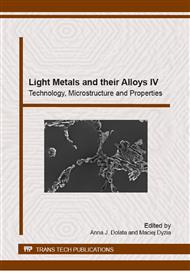[1]
Titanium and titanium alloys, Fundamentals and Applications, ed. by C. Leyens and M. Peters, WILEY-VCH GmbH & Co. KGaA, (2003).
Google Scholar
[2]
Materials Properties Handbook: Titanium Alloys, ed. by G. Welsch, R. Boyer, E. W. Collins, ASM International, 1993, pp.377-408.
Google Scholar
[3]
Information on http: /asm. matweb. com.
Google Scholar
[4]
Fatigue Data Book: Light Structural Alloys, ASM International, USA 1995, pp.238-245.
Google Scholar
[5]
H. G. Wang, F. Wang, Y. P. Song, Effect of heat treatment on microstructure and properties of Ti811 alloys, Appl. Mech. Mater. 117-119 (2012) 1032-1035.
DOI: 10.4028/www.scientific.net/amm.117-119.1032
Google Scholar
[6]
O. P. Solonina, N. M. Ulyakova, Effect of carbon on the mechanical properties and structure of titanium alloys, Materials Science and Heat Treatment 4 (1974) 310-312.
DOI: 10.1007/bf00679223
Google Scholar
[7]
H. R. Ogden, R. I. Jaffee, The effects of carbon, oxygen, and nitrogen on the mechanical properties of titanium and titanium alloys, Titanium Metallurgical Laboratory Report No. 20, Ohio (1955) 1-101.
DOI: 10.2172/4370612
Google Scholar
[8]
J. Grauman, S. Fox, S. Nyakana, Titanium alloy having improved corrosion resistance and strength, United States Patent US2006/035867 (2001).
Google Scholar
[9]
Z. Q. Chen, Y. G. Li, M. H. Loretto, X. Wu, Role of alloying elements in microstructures of beta titanium alloys with carbon additions, Mater. Sci. Tech. 10 (2003) 1391-1398.
DOI: 10.1179/026708303225005999
Google Scholar
[10]
Z. Q. Chen, Y. G. Li, D. Hu, M. H. Loretto, X. Wu, Effect of carbon additions on the microstructure and mechanical properties of Ti-15-3, J. Mater. Sci. Technol. 20 (2004) 343-349.
Google Scholar
[11]
A. Szkliniarz, W. Szkliniarz: Assessment quality of Ti alloys melted in induction furnace with ceramic crucible, Solid State Phenom. 176 (2011) 139-148.
DOI: 10.4028/www.scientific.net/ssp.176.139
Google Scholar
[12]
A. Szkliniarz, W. Szkliniarz, Effect of solution treatment on the microstructure of Ti-C alloys, Solid State Phenom. 212 (2014) 7-10.
DOI: 10.4028/www.scientific.net/ssp.212.21
Google Scholar
[13]
G. Lütjering, J. C. Williams, A. Gysler, Microstructure and Mechanical Properties of Titanium Alloys, in: J.C.M. Li (Ed. ), Microstructure and Properties of Materials, World Scientific, Singapore, 1998, pp.1-77.
DOI: 10.1142/9789812793959_0001
Google Scholar
[14]
Information on http: /www. RMITitanium. com.
Google Scholar
[15]
Information on http: /www. titaniuminfogroup. com.
Google Scholar
[16]
Information on http: /www. timet. com.
Google Scholar
[17]
Titanium alloys handbook, R. A. Wood, R. J. Fawor, Metals and Ceramics Information Center Report No. MCIC HB-02, (1972).
Google Scholar


